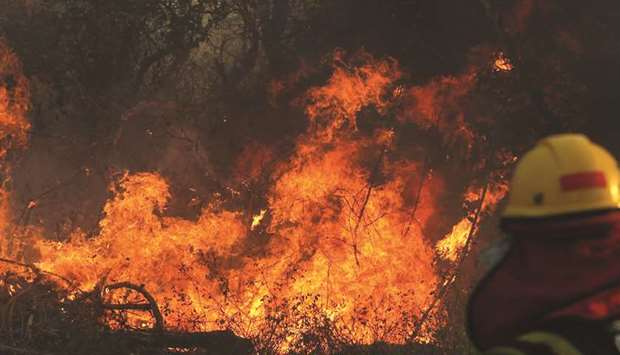We live in an era when the Amazon rainforest, the largest of its kind in the world, is facing a never-before-threat in the form of raging fires on top of the other forms of deforestation happening at an accelerated pace.
The Amazon rainforest, often described as our planet’s lungs, occupies around 7 million square km within nine countries, with Brazil having around 80% of it.
Researcher Diego Mosquera, who has lived in the Amazon and studied its biodiversity for the last 15 years, puts that into perspective thus: “One third of the species on earth live in the Amazon, and it is documented as the one of most diverse ecosystems in the world.”
Wildfires in the Amazon rainforest have hit a record number this year, according to research carried out by Brazil’s space research centre. It cites 72,843 fires, marking an increase of 83% compared to 2018 — the highest since records began in 2013.
On behalf of Gulf Times, I had interacted with Mosquera during a trip to Tiputini Biodiversity Station, deep inside the Amazon rainforest in Ecuador in February 2013. The remoteness of the facility can be gauged from the fact that it takes a 40-minute flight from Ecuador’s capital Quito to reach the domestic airport in Coca, followed by a six-hour journey (two hours each by boat, an open bus and again boat) to reach there.
Mosquera, the research co-ordinator at Tiputini with many publications to his credit, conveyed his views about the current situation in the Amazon rainforest, in an e-mail interview:
“Apart from its incredible diversity, the Amazon is responsible for capturing carbon, providing oxygen and it is also a global temperature regulator. “Contrary to what the majority of people think, the Amazon does not have fertile soils and it is not good for agriculture. The fertile soil layer of the Amazon is very small in depth and it consists of mostly clay.
“The fact that you see so many trees is because they have evolved nutrient extraction mechanisms over thousands of years. These mechanisms have turned the Amazon into a very complex ecosystem that is not replaceable once it is lost.
“Since the 1970s, about 20% of the Amazon has been deforested, mainly for the conversion of the forest to cattle ranching, which is biggest single direct driver of deforestation.
“If you add other activities like large scale industrial agriculture (especially for soy plantations), urban expansion, and timber plantations, the scenario doesn’t look good.
“As if that wasn’t enough, in the last decades, the interest in the Amazonia also comes from activities like oil extraction, mining and hydropower plants, bringing not only deforestation, but also high levels of pollution.
The fires
“In some ecosystems, the fires are important to maintain the ecological equilibrium. But the Amazon is not one of them, and this is why, historically, fires are not part of the natural cycles of the forest.
“In the Amazon, species are not adapted to fires, and this causes a big problem. When there is a big fire, some species will have more chances to escape, like large animals or some birds, but most of them have no chance to survive large-scale fires like the ones taking place in the last few weeks. There are species that are already seriously threatened, and fires will be the last nail in the coffin for them.
“Once the forest is burned, 99% of species will be lost. And even though we know a lot about the Amazon, at the same time we don’t know much, so we could be losing species that we don’t even know exist.
“What most people don’t understand is that the Amazon has evolved for thousands of years in very complex ways, so once we lose it, it’s lost forever.
“We simply cannot “recover” the Amazon by replanting trees, as the ecological integrity of the forest is lost forever. If carbon sequestered by the Amazon over the centuries is released, it will aggravate the climate crisis further.
“As a researcher living in the amazon for many years, I have witnessed many changes in the last few years. Even though I work in an area relatively well preserved, some impacts are very notorious. For example, we have noticed serious declines in numbers of birds, amphibians and insects. These are changes that we cannot attribute to specific activities yet, but we presume that are part of a bigger picture, the global climate crisis.
“Extensive human activities are making the problem even worse, because more and more people are having access to the last remnants of primary forest without any sort of management plans.
“In countries where there is a policy that in simple words encourages deforestation for “economic growth”, the situation is much worse.
“It is imperative that the world realise what it is at stake here. We need leaders committed to conservation, better laws, more protected areas and especially, we need to become responsible consumers.”

ALARM: A view of the raging fires in the Amazon forest. According to Diego Mosquera, u201conce the forest is burned, 99% of species will be lostu201d. Wildfires in the Amazon rainforest have hit a record number this year, according to research carried out by Brazil’s space research centre. It cites 72,843 fires, marking an increase of 83% compared to 2018 u2013 the highest since records began in 2013.


